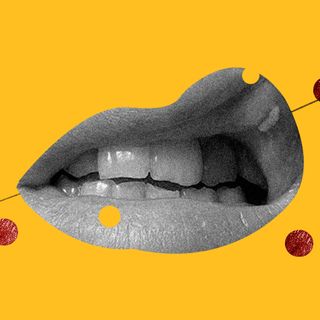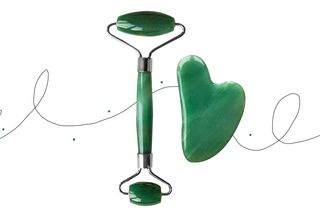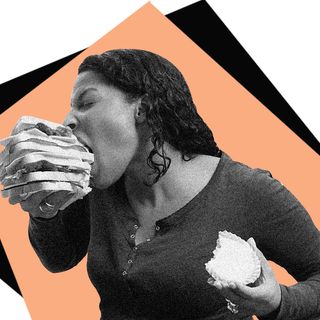
Untrending: Face Rollers Are Soothing, but Don’t Have Any Long‑Term Skin Benefits
However, the same benefits can be achieved by massaging and icing one’s face.

In Untrending, we side-eye the latest fads so we know what we’re getting ourselves into — and what (if anything) we’re getting out of them.
Face rollers are beautiful tools. Made of jade or rose quartz, they are meant to be delicately rolled upon the face to bring about a host of benefits, including flushing out toxins, slimming the face, contouring the face, improving mood and lending spiritual benefits. However, as with many beauty rituals, face rollers come shrouded in misinformation and exaggerations about their effectiveness.
Face rollers may be photogenic, but they also have a rich history. Based on Traditional Chinese Medicine techniques, face rollers made from jade can trace their heritage back to the Qing dynasty. Emperors utilized jade — a precious stone symbolizing health, wealth, longevity and prosperity –to draw out negative energy. The royalty aspect only adds to the face rollers’ current allure — at the Mandarin Oriental Hotel in Hong Kong, one can opt for something called the ‘Imperial Jade Treatment’ in the spa, incorporating a herbal compress, massages, scrubs, masks, and finally, cool Jade face rollers to lift and tone one’s face. Plus, celebrities like real-life royalty Meghan Markle swear by it.
A major benefit attributed to face rollers is that they aid lymphatic drainage. Lymphatic fluid helps remove waste and toxins built up around the body, and face rollers are supposed to aid that process. However, lymph drainage is a natural process that doesn’t really need an aid, unless lymph fluid clogs in the lymph nodes due to serious medical conditions like fibromyalgia and lymphedema. Plus, the science behind manual lymphatic drainage is “founded upon hypotheses, theory, and preliminary evidence” according to a systematic, scientific review of the process in a medical context. Another investigation by the New Statesman called lymphatic drainage processes pseudo-scientific in the wellness and beauty context.
In a study published in the Journal of Clinical Investigation, academic dermatologist George Cotsarelis wrote, “I don’t actually understand what is meant by ‘reduction in fluid buildup’ as pertains to the skin unless they mean edema from heart failure — but your kidneys do that for you, not your skin.” He added, “And when do you even have lymphatic drainage problems? If you do, you’re certainly not going to get a facial to solve them. A [healthy] person does not [usually] have lymphatic problems on their face.” Therefore, one can’t say with certainty that face rollers ‘detoxify’ anything in that sense.
Related on The Swaddle:
Untrending: Please Don’t Stick a Jade Egg up Your Vagina
What massaging one’s face with jade rollers does is stimulate blood flow and vasodilation temporarily. This temporarily makes the skin look fresh and well-rested. However, one doesn’t require a face roller to create this benefit — simply massaging the face in circular motions can do the trick.
Another supposed beauty benefit of face rollers is that they lead to a slimmer, more contoured face. But the only way to get a more permanent slim face is via a healthy diet and exercise. Faces do get temporarily puffy or bloated due to foods heavy in sodium, alcohol, stress, hormones, pregnancy, hypothyroidism, and certain allergies. And face rollers are said to reduce this facial puffiness, thereby giving the face a more contoured, angular appearance. This is some merit in this assertion. Face rollers are usually made out of precious stones like jade and rose quartz which are naturally cool, or can maintain cold temperatures for a long period of time. Using cold stones, or ice, or cold water or cucumber slices on one’s face helps dilate blood vessels under the face, which reduces puffiness. However, face rollers cannot change facial angles — only overall weight loss can do that.
Plus, the efficacy of face rollers with respect to reducing puffiness is heavily dependent on face rollers having real stones to create the low temperature effect. Jade, in particular is an expensive stone, with the cheapest variant (nephrite jade) still costing a lot more than what ‘jade’ rollers on popular e-commerce platforms sell for. Some jade rollers sell for as much as USD $90 (INR 6700), which makes ice (free if you have a fridge) a significantly better bargain.
Related on The Swaddle:
The Fantasy of Elevated Daily Lives Is What Keeps Us Hooked to Influencer Routine Videos
Which brings us to the spiritual and mood-based benefits of face rollers. While there’s no research that can scientifically prove the spiritual benefits of face rollers, it is proven that facial massages reduce anxiety and calm negative moods. While here too, one doesn’t need a face roller to reduce one’s anxiety, it might add to the experience. According to research published in Philosophical Transactions, ritualistic healing practices can behave like a placebo enacting neurobiological changes. If one believes the face roller makes them feel better, it just might.
While face rollers are somewhat not a scam or actively harmful, they certainly seem like luxury items that can be replaced with simpler means to reach the same goal. However, if purchasing one of these stone beauties feels like a treat, there’s absolutely no harm.
Aditi Murti is a culture writer at The Swaddle. Previously, she worked as a freelance journalist focused on gender and cities. Find her on social media @aditimurti.
Related


Is Crisis Fatigue Leading Us to Avoid the News?
